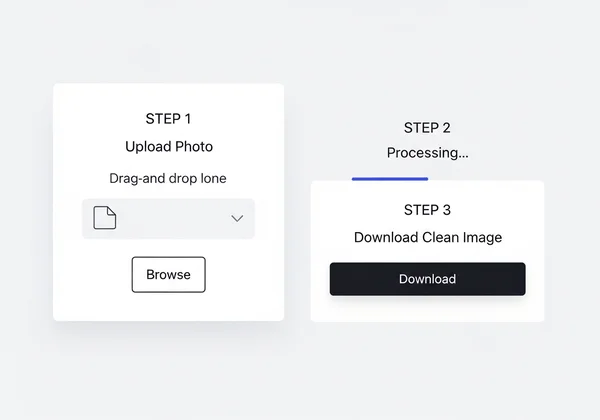How to Remove Metadata from Photos: A Real-World Privacy Test with Our Free Online Tool
Introduction: The 'Aha!' Moment: Uncovering My Own Photo Privacy Risks
I’ve always loved sharing my vacation photos. That incredible sunset in Bali, the bustling market in Marrakesh, a family selfie at the Grand Canyon—these are moments I want my friends and family to see. I used to think a photo was just a photo. A simple snapshot in time. I couldn't have been more wrong. My 'aha!' moment came after a friend in tech casually asked if I ever remove metadata from photo files before posting them online. I laughed it off, but his question stuck with me. It led me down a rabbit hole that completely changed how I view online sharing. What can metadata reveal? As I discovered, the answer is: a shocking amount. This is the story of my real-world privacy test and how I found a simple way to reclaim control over my digital footprint. If you've ever posted a picture online, you need to read this.
What I Discovered: Unveiling Hidden Metadata in My Travel Shots
My curiosity was piqued. I started with a photo from my recent trip to Italy—a beautiful shot of my family in front of a small, charming restaurant in a quiet village. To me, it was just a happy memory. To my computer, it was a file packed with hidden information. I used a few online tools to inspect the image and was floored by what I found embedded within the file itself. This wasn't just pixel data; it was a digital breadcrumb trail leading right back to me. It became clear that to protect my privacy, I needed an effective way to remove picture metadata.

GPS, Device & Time: The Specifics of My Exposed Data
The first thing that jumped out was the GPS coordinate data. With a single click, I could see the exact latitude and longitude of that tiny restaurant, pinpointed on a map. It wasn't just the city; it was the specific street corner. But it didn't stop there. The EXIF data—a standard for metadata in images—also revealed the exact make and model of my smartphone, the date and time the photo was taken (down to the second), and even the camera settings I used. It felt like a massive overshare I never consented to. Anyone could figure out my travel dates, the expensive gear I was using, and the exact locations I frequented.
My Initial Scans: Comparing Tools to Find Photo Metadata
My investigation turned into a mission. I wanted to understand how easily this information could be accessed. I tried several methods, from built-in operating system viewers to other online metadata checkers. Some were complicated and clunky, filled with technical jargon that was hard to decipher. Others seemed a bit sketchy, and I was hesitant to upload my personal photos to just any website. This initial search highlighted a major problem: while the data was easy for others to find, checking and removing it wasn't always straightforward. I needed a solution that was as simple as it was secure, which is what eventually led me to an online metadata remover that changed everything.
Why This Matters: The Real Dangers of Sharing Metadata-Rich Photos
Discovering this hidden data was one thing; understanding its implications was another. At first, I thought, "Who would care about the location of my lunch?" But the more I thought about it, the more uneasy I became. This wasn't just about one photo. It was about the cumulative effect of hundreds of photos shared over years, each one a tiny pin on the map of my life. This invisible data creates a detailed profile of your habits, routines, and personal life that can be exploited by people with malicious intent.

From Location Tracking to Personal Identity Theft: The Risks
The dangers are very real. A collection of geotagged photos can reveal your home address, your children's school, your daily commute, and when you're away on vacation—making you a target for burglary. For professionals like photographers or journalists, it can expose sensitive client locations or confidential sources. Beyond physical safety, this data can be scraped and compiled by data brokers to build an alarmingly accurate profile of you, which can be sold for marketing or even used for identity theft. The risk is not hypothetical; it's a tangible vulnerability in our digital-first world. This realization made me prioritize photo metadata removal as a non-negotiable step before sharing anything.
How Unwittingly I Shared More Than I Intended Online
The most unsettling part of this entire experience was realizing I had been doing this for years. Every photo of my dog at our local park, every picture from a family birthday party at home, every snapshot of a fun night out with friends—they were all potential privacy leaks. I was unwittingly sharing a detailed log of my life with the entire internet. It’s a strange feeling, knowing you’ve exposed so much without ever meaning to. This experience taught me a crucial lesson: in the digital age, what you don't share is just as important as what you do. Finding a way to strip exif data became essential for my peace of mind.
Taking Control: My Easy Solution for Removing Photo Metadata
After the initial shock and concern, I felt a surge of determination. I wasn't going to stop sharing my life's moments, but I was going to do it on my own terms. I needed a tool that was fast, free, secure, and incredibly simple. My search ended when I found the perfect online metadata remover. It was exactly the easy solution I was looking for, designed for people like me who care about privacy but aren't tech wizards. It didn't require any downloads, installations, or complicated sign-ups.
A Simple 3-Step Process: Using Our Online Metadata Remover Effectively
The beauty of this tool is its simplicity. It turned what seemed like a complex technical problem into a quick, effortless task. Here’s the exact process I now follow for every single photo I share:
-
Upload the Photo: I simply drag my photo file directly onto the homepage or click to select it from my computer.
-
Instant Removal: The tool automatically and instantly processes the image, stripping away all the hidden EXIF data—the GPS, device info, timestamps, everything. The website's commitment to privacy is clear; they state they never store your images, which was a huge factor in trusting them.
-
Download the Clean Image: A "Download" button appears immediately. I click it, and I have a clean, metadata-free version of my photo, ready to be shared safely.

That's it. The entire process takes less than ten seconds. It’s now a seamless part of my workflow before posting anything to social media.
The Relief of Knowing My Photos Are Truly Private
The feeling after using the tool for the first time was one of profound relief. It's empowering to know that when I share a photo now, I'm only sharing the image itself—not my location, not my schedule, not my personal information. I can post my vacation pictures freely, knowing that I'm not broadcasting my empty house to the world. It’s a small step that makes a huge difference in protecting my digital identity. If you're ready to feel that same peace of mind, you can try the free tool right now.
Share Safely, Live Freely: Reclaiming Your Photo Privacy Today
My journey started with a simple question and ended with a powerful solution. I learned that our photos carry more than just memories; they carry sensitive data that can put our privacy at risk. But the good news is that taking back control is easier than you think. You don't have to stop sharing the moments that matter. You just have to share them smarter.
By taking a few seconds to clean your images, you close a significant digital vulnerability and ensure your private life stays private. Don't wait for a negative experience to make you care about your photo's hidden data. Be proactive. Take control of your digital footprint today and share with confidence. Visit MetadataRemover.org to protect your photos in seconds.
Your Photo Privacy Questions Answered
What exactly is metadata in a photo and what does it reveal?
Metadata, often called EXIF data in photos, is hidden information embedded in the image file. It acts like a digital label, recording details such as the GPS location where the photo was taken, the date and time, the specific camera or smartphone model used, and even camera settings like ISO and shutter speed. It can reveal your personal habits, locations, and routines.
Why is it important to remove metadata before sharing photos online?
Removing metadata is crucial for protecting your privacy and security. It prevents strangers from discovering your home address, workplace, or travel patterns. For parents, it's essential for protecting a child's location. For professionals, it safeguards client confidentiality. Essentially, clearing this data ensures you only share the visual moment, not a map of your life, making secure photo sharing possible.
Is using an online tool like MetadataRemover.org safe for my privacy?
Yes, when you choose a trustworthy tool. The key is to use a service that processes images without storing them. MetadataRemover.org is designed with a privacy-first approach, stating clearly that they do not save or store any user-uploaded photos. The removal process is automated and immediate, ensuring your images remain yours and yours alone, offering a safe way to clear metadata.
How can I check my own photos for hidden data before sharing?
While some operating systems let you view file details, the easiest way to see and remove this data is with a dedicated tool. You can use an exif data remover to not only see if data exists but to scrub it clean in one simple step. Simply uploading a photo to the tool and then downloading the processed version guarantees it's free of hidden information before you post it.